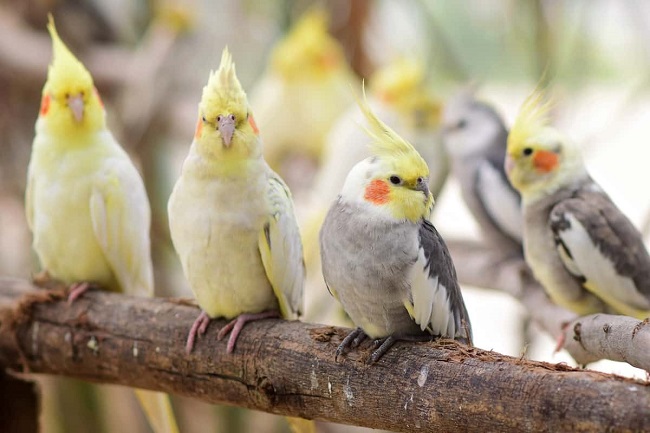Known for their endearing personalities and distinctive crests, cockatiels are a beloved pet bird species. Originating from Australia, these parrot family members come in an array of stunning color mutations and varieties, making them a favorite among bird enthusiasts.
But do you know how many types of cockatiels there are? Let’s embark on a journey to explore 9 key varieties of these adorable avian companions.

9 Types of Cockatiel Varieties & Color Mutations
Here you will find out types of cockatiel:
Read Also:
1. Normal Grey Cockatiel
Arguably the most iconic, the Normal Grey Cockatiel is the closest to its wild counterpart in Australia. They have grey bodies, white wing patches, yellow heads, and orange cheek patches.
The males feature brighter colors, while the females have grey faces and barred patterns on the tail feathers.
2. Lutino Cockatiel
The Lutino Cockatiel, often mistaken for an albino, boasts a beautiful yellow to white plumage, with brilliant red-orange cheek patches.
They lack the grey pigmentation, resulting in their striking yellow and white coloring. Both males and females look similar in this variety.
3. Cinnamon Cockatiel
Cinnamon Cockatiels showcase a warm, cinnamon-brown shade over their usual grey areas, while their yellow and orange colors remain vibrant. Females have the same barred patterns on the underside of tail feathers as their Normal Grey counterparts.
4. Pearl Cockatiel
Known for their intricate feather patterns, Pearl Cockatiels bear a beautiful pearl-like pattern on their back and wings. Their unique ‘pearling’ effect varies from fine speckling to larger patches.
Females retain these pearl markings, while males typically lose them after their first molt, appearing similar to the Normal Grey variety.
5. Pied Cockatiel
In Pied Cockatiels, the standard grey color is interrupted with patches of yellow or white. This striking variety has a random pattern that’s unique to each bird. The placement and extent of the color patches can widely vary, making each Pied Cockatiel distinct.
6. White-Faced Cockatiel
White-Faced Cockatiels lack the yellow and orange pigmentation, resulting in a pure white or silver face, regardless of the body color.
When combined with other mutations, this can lead to White-faced Lutino, White-faced Cinnamon, or White-faced Pied varieties, each carrying its own charm.
7. Silver Cockatiel
In the Silver Cockatiel, the usual grey is replaced by a silver shade, giving them a unique and delicate appearance. They can be combined with other mutations, like the White-face or Pied, to create combinations like Silver White-Faced or Silver Pied Cockatiels.
8. Yellowcheek Cockatiel
Yellowcheek Cockatiels, a newer mutation, possess a gorgeous blend of colors. Their cheek patches are a blend of yellow and orange, creating a delightful, warm effect. The body color varies based on whether they have inherited other color mutations.
9. Albino Cockatiel
Contrary to popular belief, Albino Cockatiels aren’t a distinct mutation but are a combination of the Lutino and White-faced varieties. They are entirely white with red eyes, lacking any yellow or orange pigmentation.
Understanding Cockatiel Mutations
The fascinating color variations in cockatiels come from various genetic mutations. In addition to individual mutations, many cockatiels are a mix of two or more mutations, leading to an exciting range of possible appearances.
Read Also:
Conclusion
Cockatiels, with their unique color mutations and charming personalities, make delightful companions. Whether you are drawn to the classic Normal Grey or the intriguing Pied, there’s a cockatiel variety that will captivate your heart.
These nine types represent just a glimpse into the fantastic world of cockatiel color mutations, each type bringing its unique touch of beauty and character.
The vibrant world of cockatiels offers endless delight to bird enthusiasts, making them a much-cherished addition to the avian family.
























